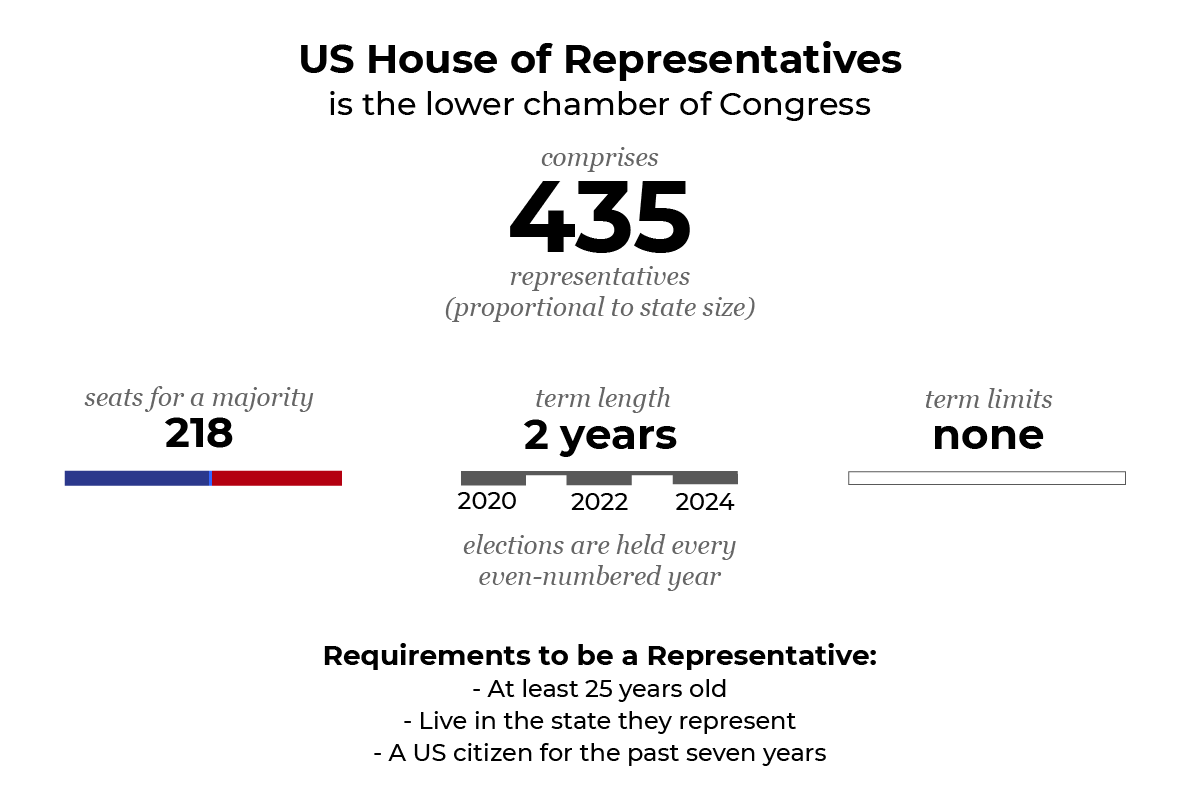Table Of Content

The House has 23 committees while the Senate has a total of 20 committees. House of Representatives each represent a portion of their state known as a Congressional District, which averages 700,000 people. Equivalently, the governors of Indiana[71] and Oregon[72] are limited to serving 8 out of any 12 years. Conversely, the governors of Montana[73] and Wyoming[74] are limited to two terms, serving 8 out of any 16 years. Members of Congress in both houses are assigned to committees with specific areas of interest (e.g., the Intelligence Committee, the Agriculture Committee).
Information about voting
The bicameral relationship between the two bodies is vital to the American system of checks and balances that the Founding Fathers of the United States envisioned when writing the U.S. The House of Representatives is part of the Legislative branch of government. So they will not all be up for election at the same time, their terms are staggered. Every two years, during each midterm and presidential election year, a different third of the Senate is elected. [T]he constitutional prerogative of the House has been held to apply to all the general appropriations bills, and the Senate's right to amend these has been allowed the widest possible scope.
in 10 Americans Say Religion Is Losing Influence in Public Life
McCarthy has lost the gavel. It was the third shortest speakership in history. - CNN
McCarthy has lost the gavel. It was the third shortest speakership in history..
Posted: Tue, 03 Oct 2023 07:00:00 GMT [source]
Some State government offices are also term-limited, including executive, legislative, and judicial offices. The U.S. Congress is the legislative branch of the U.S. government. Congressional elections determine who represents your state in the federal government and which political party will hold a majority in each chamber for the next two years.
Special elections
Members of Congress represent the people of their district in the United States Congress by holding hearings, as well as developing and voting on legislation. In conclusion, the duration of a congress term holds immense significance, shaping the representation, decision-making, and stability of the legislative branch. It is a topic that demands ongoing deliberation and consideration to ensure the effectiveness and responsiveness of Congress in serving the nation's interests. Public engagement and discourse play a vital role in shaping the conversation around congressional term lengths. Citizens can voice their opinions and participate in the democratic process to influence the policies and regulations that affect their lives.
Legislative committees
For example, smaller states like Vermont and Delaware have one representative while large states like California have 53 representatives. In 1861, the Confederate States of America adopted a six-year term for their president and vice president and barred the president from seeking re-election. That innovation was endorsed by many American politicians after the Civil War, most notably by Rutherford B. Hayes in his inaugural address. Ulysses Grant was urged to run for a third term in 1876, but he refused.
All articles are regularly reviewed and updated by the HISTORY.com team. Articles with the “HISTORY.com Editors” byline have been written or edited by the HISTORY.com editors, including Amanda Onion, Missy Sullivan, Matt Mullen and Christian Zapata. Although this process means that only a fraction of proposed legislation actually becomes law, the framers of the Constitution wanted careful deliberation in which diverse views are heard and our rights as citizens are represented and defended. Committees in both houses review bills that have been introduced by their colleagues, holding hearings in which their merits are debated. Constitution saw the two houses as having distinct roles, with the House designed to serve as a forum for more pressing, everyday concerns, while the Senate was intended to be a place for calmer deliberation. The Senate includes 100 members, with each of the 50 states electing two senators to this body of Congress to six-year terms.

Public Policy
Congress deals with a broad variety of different policy issues and it is more efficient to have work done at the committee level than on the House or Senate floor. In addition, this system allows members to gain expertise in specific issue areas they are interested in. Throughout history, committees have been created to address particular issues before Congress.
The Constitution does not specify the duties and powers of the speaker, which are instead regulated by the rules and customs of the House. Speakers have a role both as a leader of the House and the leader of their party (which need not be the majority party; theoretically, a member of the minority party could be elected as speaker with the support of a fraction of members of the majority party). Under the Presidential Succession Act (1947), the speaker is second in the line of presidential succession after the vice president. The states of Washington and California use a similar (though not identical) system to that used by Louisiana. With the advanced age of some U.S. political leaders in the spotlight, 79% of Americans favor maximum age limits for elected officials in Washington, D.C. And 74% support such limits for Supreme Court justices, according to a new Pew Research Center survey. In the ten states where the limits are consecutive, once a state legislator has served the maximum number of terms in office, he or she, if eligible, can run for office for the state's other legislative chamber, or leave the legislature.
Term limits in the United States
When it comes to understanding how the United States Congress works, one of the first topics to consider is the length of congressional terms. The term length for members of Congress is set by the Constitution, and it is two years for each member of the House of Representatives and six years for each member of the Senate. This means that every two years, all members of the House of Representatives must stand for re-election. The number rose following the ratification of the Constitution by North Carolina and Rhode Island in 1790; the first Congress (1789–91) adjourned with 65 representatives.
Reformers during the early 1990s used the initiative and referendum to put congressional term limits on the ballot in 24 states. Voters in eight of these states approved the congressional term limits by an average electoral margin of two to one.[31] It was an open question whether states had the constitutional authority to enact these limits. Term Limits, Inc. v. Thornton, 514 U.S. 779 (1995), that states cannot impose term limits upon their federal representatives or senators. The Constitution vests certain exclusive powers in the House of Representatives, including the right to initiate impeachment proceedings and to originate revenue bills.
The organization and character of the House of Representatives have evolved under the influence of political parties, which provide a means of controlling proceedings and mobilizing the necessary majorities. Party leaders, such as the speaker of the House and the majority and minority leaders, play a central role in the operations of the institution. In deciding term lengths, Convention delegates turned to the practices of state governments.
George Read of Delaware proposed an even longer term of nine years. Madison endorsed this long term, arguing it would contribute to the “wisdom and virtue” required for the body to counter “symptoms of a levelling spirit” among the people. A few delegates, such as New York’s Alexander Hamilton, suggested that senators be granted life tenure, as existed in England’s House of Lords. Hamilton contended this was necessary to protect senators against the "amazing violence and turbulence of the democratic spirit,” but few delegates supported this idea. Governors of thirty-seven states[43] and four territories are subject to various term limits, while the governors of thirteen states, Puerto Rico, and the mayor of Washington, D.C., may serve an unlimited number of terms.
Another officer is the chief administrative officer, responsible for the day-to-day administrative support to the House of Representatives. The chairs of House committees, particularly influential standing committees such as Appropriations, Ways and Means, and Rules, are powerful but not officially part of the House leadership hierarchy. Until the post of majority leader was created, the chair of Ways and Means was the de facto majority leader. The party with a majority of seats in the House is known as the majority party. The speaker, committee chairs, and some other officials are generally from the majority party; they have counterparts (for instance, the "ranking members" of committees) in the minority party. Since 1993, the Legislature has hosted a web or FTP site in one form or another.
When the presidency and Senate are controlled by a different party from the one controlling the House, the speaker can become the de facto "leader of the opposition". Some notable examples include Tip O'Neill in the 1980s, Newt Gingrich in the 1990s, John Boehner in the early 2010s, and Nancy Pelosi in the late 2000s and again in the late 2010s and early 2020s. Since the speaker is a partisan officer with substantial power to control the business of the House, the position is often used for partisan advantage.
These states are Arizona, Arkansas, Colorado, Florida, Louisiana, Maine, Montana, Nebraska, Ohio, and South Dakota. After a period of time no longer in office in a particular legislative chamber, however, the legislator is allowed to run again for office in that legislative chamber. The period of time that a legislator must be out of office before being able to run again is usually two years. In the United States, term limits restrict the number of terms of office an officeholder may serve. At the federal level, the president of the United States can serve a maximum of two four-year terms, limited by the 22nd Amendment to the United States Constitution.

No comments:
Post a Comment